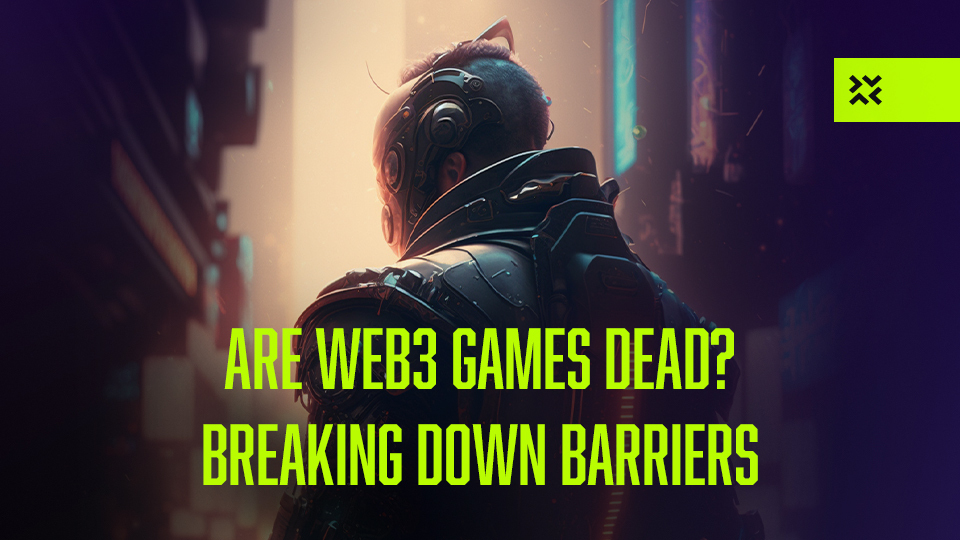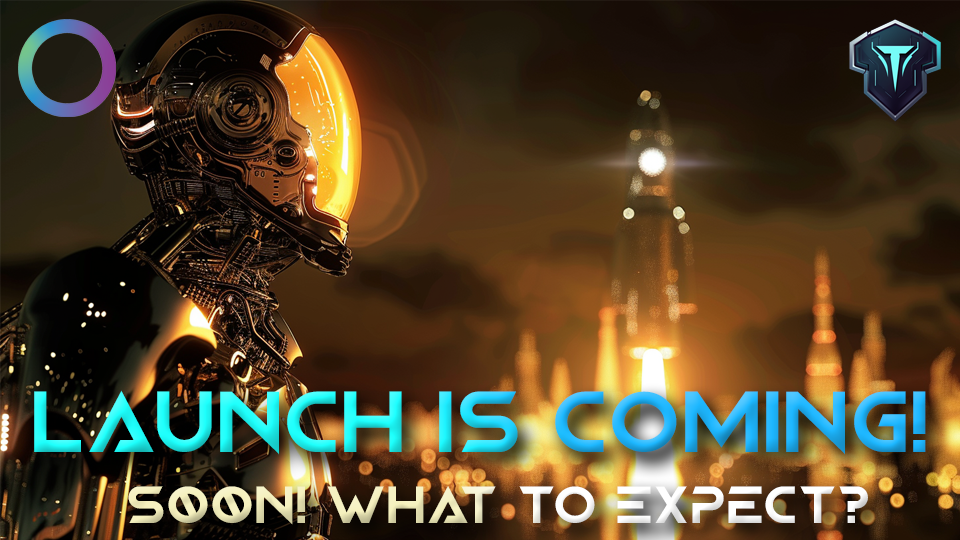
Introduction
Welcome to the world of Web3 games, where blockchain technology and crypto games are reshaping the gaming industry. Despite recent speculation about their viability, Web3 games are far from dead. Developers like Revenant are actively building, with a focus on breaking down barriers between Web2 and Web3 gamers.
In this article, we will explore the reasons behind the speculation surrounding Web3 games and highlight the efforts being made to propel the industry forward. By analyzing the current state of the market, learning from the success of Web2 gaming, and showcasing projects like Battle of Olympus, we will demonstrate that Web3 games are not only alive but poised to thrive in the coming years.
Get ready to discover the innovative spirit and resilience of the Web3 gaming ecosystem as we delve into a future of limitless possibility.
The Web3 Gaming Market Right Now
Thanks to the bear market in the broader blockchain world, the Web3 gaming market has experienced a recent downturn. This leads to some concern about its future. However, it is important to understand the context correctly and view the current situation as a temporary setback rather than a permanent decline.
The decline in the Web3 gaming market can be attributed to several factors. The volatility of cryptocurrency prices has impacted investor confidence and slowed down the development of new games. Additionally, regulatory challenges and uncertainty have created a cautious environment for developers and investors alike. Then there are some other obvious culprits: lack of professionalism, lack of commitment, lack of funding.
Despite these challenges, there is reason for optimism.
By learning from the success of Web2 gaming, developers can incorporate key elements into Web3 games to drive growth and attract a broader audience. Engaging gameplay mechanics, community building, and play-to-earn mechanics have proven to be successful in Web2 gaming and can be leveraged in the Web3 space.
By embracing these elements, Web3 games have the potential to foster sustainable growth and capture the interest of both crypto enthusiasts and traditional gamers. The convergence of blockchain technology and gaming opens up new possibilities for immersive experiences and novel economic models. This presents an exciting opportunity for developers to bridge the gap between Web2 and Web3 gaming, attracting a wider audience and driving the future success of the industry.
Bridging the Gap: Breaking Down Barriers
User Experience and Adoption Challenges
Entering the Web3 ecosystem can be daunting for mainstream gamers due to the complexities of blockchain technology. This includes navigating wallet management, understanding transaction fees, and onboarding processes. To increase adoption of Web3 games, it is crucial to prioritize improving the user experience.
Game developers, like us at Revenant with Battle of Olympus, are actively addressing these challenges. We recognize the need to simplify user interfaces, making them more intuitive and user-friendly. Efforts are also being made to minimize transactional friction, ensuring smoother interactions within the game environment. By reducing barriers and enhancing the user experience, developers are creating a more inviting and accessible space for both Web2 and Web3 gamers.
NFTs and True Ownership
NFTs (non-fungible tokens) play a significant role in Web3 games and hold great significance in the world of crypto games. NFTs allow for the representation of unique in-game assets and provide true ownership to players. This concept of true ownership has the potential to transform the gaming industry.
With true ownership, players have the ability to buy, sell, and trade their in-game assets, creating a vibrant in-game economy. Games like Axie Infinity and Illuvium have showcased the power of NFTs, attracting players who value ownership and the potential value of their digital possessions. By leveraging NFTs, Web3 game developers can offer a new level of immersion and economic opportunities, revolutionizing the gaming experience.
Interoperability and Cross-Platform Play
Web3 games have the potential to break down barriers between different platforms and foster interoperability. This means that players can seamlessly transfer assets and progress across multiple games and platforms, enhancing player engagement and the overall ecosystem.
Developers are actively working towards achieving interoperability in Web3 gaming. By enabling seamless asset transfer and progress, players can enjoy a unified gaming experience. This allows for greater continuity and provides more opportunities for exploration and collaboration. The ongoing efforts to achieve interoperability reflect a commitment to creating an inclusive and interconnected Web3 gaming landscape.
By addressing user experience challenges, leveraging NFTs for true ownership, and promoting interoperability, Web3 game developers are breaking down barriers and creating an environment that fosters growth and engagement. These advancements are key to bridging the gap between Web2 and Web3 gaming, bringing us closer to a future where gaming experiences transcend platforms and boundaries.
Battle of Olympus: A Beacon of Hope
Overview of Battle of Olympus
Battle of Olympus, developed by Revenant, is an extraordinary Web3 arcade fighting game that showcases the potential of the Web3 gaming ecosystem. With its captivating gameplay mechanics and immersive experience, Battle of Olympus takes players on an exhilarating journey in a blockchain-powered world. What sets Battle of Olympus apart is the integration of NFTs, allowing for true ownership of in-game characters and assets. This unique feature adds a layer of authenticity and value to the gaming experience.
Breaking Barriers with Battle of Olympus
Battle of Olympus serves as a bridge between Web2 and Web3 gamers, addressing the barriers that have traditionally separated these two communities. The game offers an intuitive user experience, reducing the learning curve associated with Web3 gaming. By streamlining complex processes and providing user-friendly interfaces, Battle of Olympus opens the door for a wider audience to explore the exciting world of Web3 games.
Moreover, Battle of Olympus incentivizes both Web2 and Web3 gamers to participate through its play-to-earn opportunities. By offering rewards and incentives that can be earned and monetized within the game, Battle of Olympus provides a tangible value proposition to players. This approach not only attracts existing Web3 enthusiasts but also entices traditional gamers to venture into the realm of blockchain gaming.
Battle of Olympus: A Catalyst for Web3 Game Revival
Battle of Olympus has the potential to be a catalyst for the revival of the Web3 gaming market. Its success can inspire other developers to explore innovative approaches in blockchain gaming and crypto games. By showcasing the possibilities of true ownership, interoperability, and engaging gameplay, Battle of Olympus serves as a testament to the potential of Web3 games.
The game demonstrates how true ownership of in-game assets through NFTs can revolutionize the gaming industry, creating new opportunities for players to invest in and trade their virtual possessions. Additionally, Battle of Olympus highlights the potential of interoperability, allowing for seamless asset transfer and progress across multiple games and platforms. These features not only enhance the gaming experience but also foster a more vibrant and connected Web3 gaming ecosystem.
With its remarkable success and forward-thinking design, Battle of Olympus beckons players to embrace the Web3 revolution. By combining immersive gameplay with the power of blockchain technology, it draws attention to the endless possibilities that lie ahead for Web3 gaming. As Battle of Olympus paves the way, more players are likely to venture into the Web3 ecosystem, bringing us closer to a future where blockchain gaming becomes the norm.
Conclusion
Throughout this article, we have explored the current state of the Web3 gaming market, analyzed the challenges it faces, and highlighted the efforts being made to overcome them. It is clear that Web3 games are not dead; rather, they are experiencing a temporary downturn that can be attributed to various factors. However, the future of Web3 gaming is filled with potential and opportunities for growth and innovation.
While the recent decline in the market has raised concerns, it is important to remember that emerging industries often experience fluctuations. The volatility of cryptocurrency prices, regulatory challenges, and the complexities of blockchain technology have contributed to the current situation. However, these setbacks should be seen as temporary obstacles on the path to a more robust and thriving Web3 gaming ecosystem.
The success of Web2 gaming has provided valuable insights and proven strategies that can be applied to Web3 games. The potential for innovation in Web3 gaming is immense, with features such as true ownership of in-game assets through NFTs and interoperability across platforms opening new avenues for immersive and interconnected gaming experiences.
In this context, Battle of Olympus stands as a promising example of the resilience and potential of Web3 games. It showcases the fusion of cutting-edge technology and captivating gameplay. Battle of Olympus breaks down barriers between Web2 and Web3 gamers, offering an intuitive user experience and play-to-earn opportunities. With its success, it paves the way for other developers to explore innovative approaches and further revolutionize the Web3 gaming landscape.
In conclusion, while the Web3 gaming market may be facing a temporary downturn, it is far from dead. The potential for growth, innovation, and interconnectedness in Web3 gaming is immense. As developers continue to push boundaries and projects like Battle of Olympus inspire others, we can look forward to a future where Web3 games thrive, creating immersive experiences and transforming the way we play. So, let us remain optimistic and embrace the exciting journey ahead in the world of Web3 gaming.





